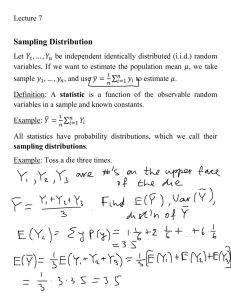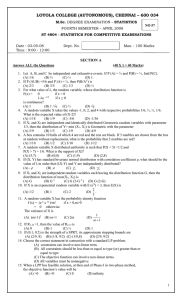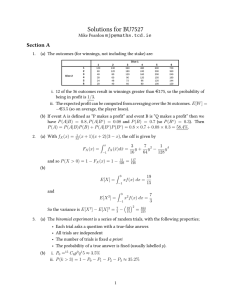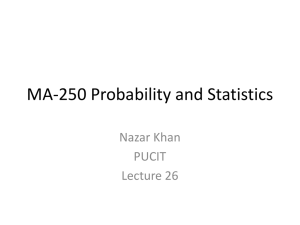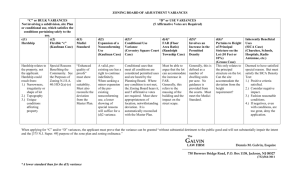lecture6
advertisement
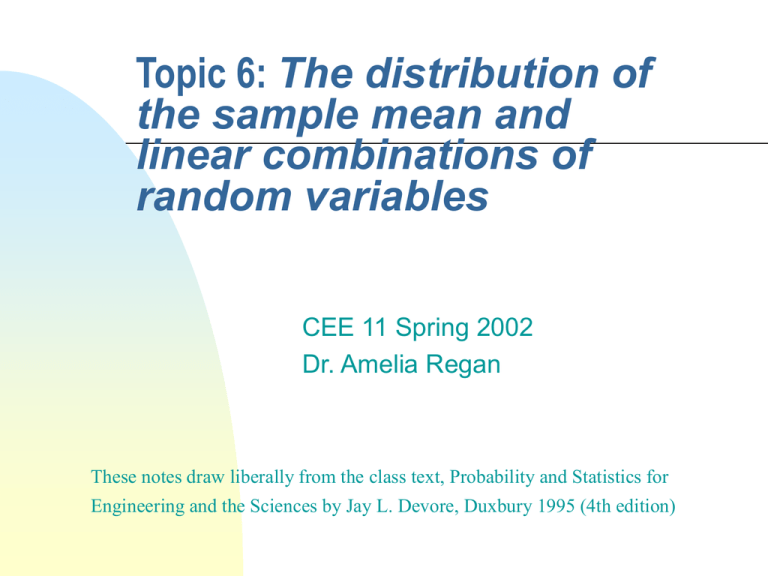
Topic 6: The distribution of the sample mean and linear combinations of random variables CEE 11 Spring 2002 Dr. Amelia Regan These notes draw liberally from the class text, Probability and Statistics for Engineering and the Sciences by Jay L. Devore, Duxbury 1995 (4th edition) The distribution of the sample mean Let X1 , X 2 , X 3 ,..., Xn be a random sample from a distribution with mean value and standard deviation . Then E(X)= x V (X)= x2 2 / n x / n In addition, the sample Total To X1 X 2 X 3 ...X n E(To )=n V (To )=n x2 T n o The Case of a Normal Population Distribution Let X1 , X 2 , X 3 ,..., Xn be a random sample from a normal distribution with mean value and variance 2 . Then for any n, X is normally distributed with x and x2 2 / n and To is also normally distributed with To =n and T2o n 2 . The Central Limit Theorem Let X1 , X 2 , X 3 ,..., Xn be a random sample from a distribution with mean value and variance 2 . Then if n is sufficiently large X has approximately a normal distribution with x and x2 2 / n and To also has approximately a normal distribution with To =n and T2o n 2 . The central limit theorem The larger value of n, the better the approximation. What are the implications? Significant! It means that we can use the normal distribution to describe and analyze data from distributions about which we know only the mean and the variance. In n > 30 we can invoke the central limit theorem Example The nicotine content in a single cigarette of a particular brand is a random variable with mean = 0.8 mg and = 0.10 mg. If an individual smokes 5 packs of these cigarettes per week, what is the probability that the total amount of nicotine consumed in a week is at least 82 mg? No matter what the underlying distribution, the total amount of nicotine consumed is approximately normally distributed with (0.80)(20)(5) 80.0 100(0.10) 1.0 Example Therefore the probability that the total is more than 82 is using z x 82 80 P( x 82) P( z ) 1.0 P( z 2) 1 p( z 2) 0.0228 The distribution of a linear combination The sample mean and sample total are special cases of a type of random variable that arises very frequently in statistical applications. Given a collection of n rv's X1 , X 2 , X 3 ,..., X n and n numerical constants a1 , a2 , a3 ,..., an n The rv Y a1 X 1 a2 X 2 a3 X 3 ... ...an X n an X n i 1 The random variable Y is called a linear combination of random variables The distribution of a linear combination Given a collection of n rv's X1 , X 2 , X 3 ,..., X n and n numerical constants a1 , a2 , a3 ,..., an n The rv Y a1 X 1 a2 X 2 a3 X 3 ... ...an X n an X n i 1 The special case where all the coefficients are equal to 1 gives us the sample total The special case in which all of the coefficients are equal to 1/n gives us the sample average The distribution of a linear combination Let X 1 , X 2 , X 3 ,..., X n have mean values 1 , 2 , 3 ,..., n and variances 12 , 22 , 32 ,... n2 respectively Then – whether or not the random variables (X’s) are independent E a1 X 1 a2 X 2 a3 X 3 ... ...an X n a1E X 1 a2 E X 2 a3 E X 3 ,...an E X n The distribution of a linear combination Let X 1 , X 2 , X 3 ,..., X n have mean values 1 , 2 , 3 ,..., n and variances 12 , 22 , 32 ,... n2 respectively Further – if the random variables are independent then V a1 X 1 a2 X 2 a3 X 3 ... ...an X n a12V X 1 a22V X 2 a32V X 3 ,...an2V X n
